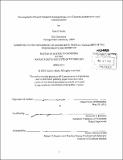| dc.contributor.advisor | Jeremiah A. Johnson. | en_US |
| dc.contributor.author | Burts, Alan O. (Alan Omar) | en_US |
| dc.contributor.other | Massachusetts Institute of Technology. Department of Chemistry. | en_US |
| dc.date.accessioned | 2013-11-18T19:10:11Z | |
| dc.date.available | 2013-11-18T19:10:11Z | |
| dc.date.copyright | 2013 | en_US |
| dc.date.issued | 2013 | en_US |
| dc.identifier.uri | http://hdl.handle.net/1721.1/82334 | |
| dc.description | Thesis (S.M.)--Massachusetts Institute of Technology, Dept. of Chemistry, 2013. | en_US |
| dc.description | Cataloged from PDF version of thesis. | en_US |
| dc.description | Includes bibliographical references (p. 41-47). | en_US |
| dc.description.abstract | Developing a modular synthetic route to a combinatorial library of functional nanoparticles for applications like drug delivery is one of the main interests of our group. To this end, we have envisioned a novel nanoparticle architecture called a brush-arm star polymer (BASP), which has polymer brushes on the periphery shielding the core. Such nanoparticles were synthesized by, first, "graft-through" ring-opening metathesis polymerization (ROMP) of a norbornene-macromonomer to create the brush-arms, and second, cross-linking the arms with a bis-norbornene cross-linker to afford star polymers via the "arm-first" star polymer method. Functionality can be installed into the macromonomer (MM) or crosslinker preand post-polymerization. We took advantage of the highly efficient third-generation Grubbs catalyst to polymerize a polyethylene glycol (PEG) macromonomer (MM) and a bisnorbornene nitrobenzyloxycarbonyl (NBOC) photocleavable cross-linker to cross-link the brush-arms, which led to low-dispersity (Đ </=1.23) core-degradable BASPs. Controlled degradation of these star polymers was achieved by UV irradiation (365 nm). Next, a novel branched norbornene-polystyrene (PS)-polylactide (PLA)-MM was used to create pseudo-alternating copolymers and miktoarm-BASPs. Transmission electron miscroscopy (TEM) of these star polymers revealed nanoparticles with segregated domains. Also, new cross-linkers were explored containing two different bis-norbornene reversible addition-fragmentation chain-transfer (RAFT) agents. A more flexible RAFT initiator crosslinker led to high-dispersity (Đ >\=1.52) BASPs, while the more rigid RAFT initiator crosslinker led to low-dispersity (Đ </=1.05) BASPs. Finally, doxorubicin-loaded, photocleavable drug vector BASPs were synthesized from azide-functionalized BASPs. Copper-catalyzed azide-alkyne cycloaddition (CuAAC) was utilized to covalently link doxorubicin to the azide BASPs, post-polymerization. These BASPs degraded and simultaneously released their drug payload upon UV irradiation. MTT assays were conducted with these nanoparticles on MCF-7 human breast cancer cells and were shown to be non-toxic before UV irradiation and toxic afterward. | en_US |
| dc.description.statementofresponsibility | by Alan O. Burts. | en_US |
| dc.format.extent | 47 p. | en_US |
| dc.language.iso | eng | en_US |
| dc.publisher | Massachusetts Institute of Technology | en_US |
| dc.rights | M.I.T. theses are protected by
copyright. They may be viewed from this source for any purpose, but
reproduction or distribution in any format is prohibited without written
permission. See provided URL for inquiries about permission. | en_US |
| dc.rights.uri | http://dspace.mit.edu/handle/1721.1/7582 | en_US |
| dc.subject | Chemistry. | en_US |
| dc.title | Development of novel polymeric nanoparticles with tailored architectures and functionalities/ | en_US |
| dc.type | Thesis | en_US |
| dc.description.degree | S.M. | en_US |
| dc.contributor.department | Massachusetts Institute of Technology. Department of Chemistry | |
| dc.identifier.oclc | 861621490 | en_US |
